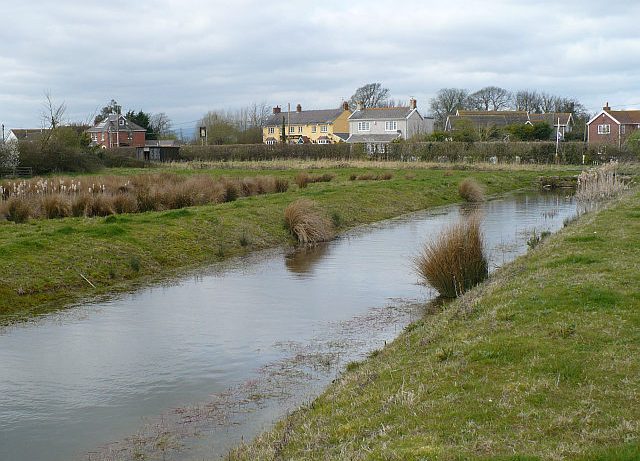Goldcliff is a small village situated within the city boundaries of Newport, within the rural county of Gwent in South Wales. The quaint village had a population of only 329 in the 2011 census.
The gold cliff
Goldcliff claims its name from the imposing cliff face that towers over the nearby Hill Farm. The 60-foot cliff is made of siliceous limestone; when the sun hits the cliff at a certain angle, it takes on a golden sheen – hence the village’s name. This glow can be seen best by boat.
Gerald of Wales, a priest and royal clerk to the king, toured Wales in 1188. Upon visiting Goldcliff – previously known as Gouldclyffe – he described this particular cliff as “…glittering with a wonderful brightness.”
He further described Goldcliff as thus:
Not far hence is a rocky eminence, impending over the Severn, called…Gouldcliffe or golden rock, because from the reflections of the sun’s rays it assumes a bright golden colour.
This was one of the earliest known recordings of the gold cliff and the village.
History
The village dates back to the Iron Age and has been marked by the cultural influence of the Romans, Vikings, and Normans.
The area was first occupied by the Romans. After building the nearby town of Caerwent, they saw the potential of the fertile soil at Goldcliff and decided to cultivate it. They dug ditches and enclosed the salt marsh – the Caldicot Levels – with a sea wall that still exists today. When Normans came to occupy the area in the 11th century, they rebuilt the sea walls, alongside monks from the local priory.
During the 19th century, the village was home to several industries, including brickworks, a paper mill, and rope works. The remains of potteries and lime kilns can be spotted in the surrounding countryside.
For centuries, Goldcliff has remained a small rural community, although it retains its historical importance. The legacy of this village has survived in folklore and literature. The main drainage ditch is called ‘Monksditch’, referring to the priory’s monks who helped build it, and its banks are said to be laced with brandy left by smugglers operating along the coast. The village is also mentioned in the Doomsday Book.
The priory
One of the most historical sites in Goldcliff was the priory at Hill Farm. The Benedictine priory was founded in 1113 by Robert de Chandos. It was the subject house to the Abbey of Bec in Normandy, and housed 25 monks in 1295; these monks were unique as their habits were white rather than the usual black colour.
The monastery met its end in the 15th century due to the dissolution of the monasteries, orchestrated by Henry VIII. It was re-founded as a cell of Tewkesbury Abbey before it was left to ruin.
The Newport Wetlands National Nature Reserve
Goldcliff is home to part of the extensive Newport Wetlands. They were opened in March 2000 to help counter the loss of mudflats caused by the building of the Cardiff Bay Barrage.
The Goldcliff Lagoons
The Goldcliff Lagoons form the eastern end of the reserve and are just south of the village.
The site consists of three shallow saline lagoons, named Monk’s, Prior’s and Bec’s respectively; they are overlooked by a series of hides and viewing platforms, so visitors can observe the local wildlife. Although there is no official platform on the seawall, ascending to the top of the wall rewards you with great views.
In spring, the lagoons become home to nesting birds; later in the year, the site becomes a pit-stop for migratory ducks and waders fleeing the cold of northern Europe. Notably, it is the only site in South Wales with breeding avocet. Over 400 species of invertebrates have also been recorded here, including rare species such as the great silver water beetle and the shrill carder bee.
The lagoons are surrounded by a variety of wildlife-friendly habitats, such as grassland, reedbeds, and mud flats.
Village amenities
Just north of the lagoons is the village itself. Highlights of Goldcliff include the 12th-century St Mary’s church, the tea rooms by the seawall and the local village pub The Farmer’s Arms.
The village viewpoint
A hidden gem in Goldcliff is the viewpoint.
To reach the viewpoint, follow the concrete steps behind the Sea Wall tearoom, then turn left and walk along the grass pathway about 200m. You will then be rewarded with a clear view of the estuary. With the gold cliff to your right, jutting out over the estuary, and the Caldicot Levels stretching out in front of you, the viewpoint provides picturesque views. At low tide, you might spot the wooden remains of ancient fish traps; Goldcliff has a long history of putcher fishing, a type of fishing involving baskets and large wooden frames.
Hiking
The countryside surrounding Goldcliff is abundant with nature and laced with little footpaths.
The Goldcliff Rock Walk is an easy and peaceful route for less experienced hikers. This circular route is around 1.5 miles long and will take around 40 minutes to complete. It offers stunning views of the Severn Estuary and the surrounding countryside.
If you’re after a more challenging route, then the Goldcliff-Llanwern Circular Walk offers 4 miles of picturesque meadows and woodlands. Along the way, you will have the opportunity to spot a variety of wildlife, as well as some interesting historical monuments. The route takes around 2.5 hours to complete. The Goldcliff-Portskewett Circular Walk is another longer route. 6 miles long, this hike usually takes 4 hours to complete and traverses open fields, ancient woodlands, and along the banks of the Severn Estuary.
For the avid hiker, the Goldcliff-Usk Circular Walk is one of the longest and more challenging routes, at around 8 miles long.
With its beautiful green countryside and abundant nature, Goldcliff is a quiet spot for birdwatchers and hikers.
Cover Image: Robin Drayton, CC BY-SA 2.0, via Wikimedia Commons

